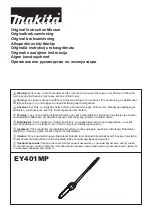
26
26
Instead of purchasing a wide assortment of styles from
the start, the scroller may find a few carefully selected
styles will serve most of his or her needs. The selection
can be expanded as the scroller gains experience.
Tooth Form
Figure 30 shows common blade forms. Tooth form has
an effect on cutting rate.
Regular:
Standard blade form with evenly spaced
teeth and zero-degree rake angle. Offers clean cuts at
slower feed rates.
Skip Tooth:
More space between teeth, for good chip
removal and fast cuts.
Double Tooth:
A skip tooth with larger gaps between
tooth sets; good chip removal, fast cutting.
Reverse Tooth:
Prevents underside tear-out, leaves
clean edge.
Spiral:
Cuts on all sides without turning workpiece;
limited applications but good for looser fretwork.
Crown Tooth:
Cuts on both up and down strokes for
clean, splinter-free edges. Depending on blade
oscillation settings, a crown tooth blade may often be
turned over for a fresh set of cutting teeth.
Figure 30: Blade Forms















































